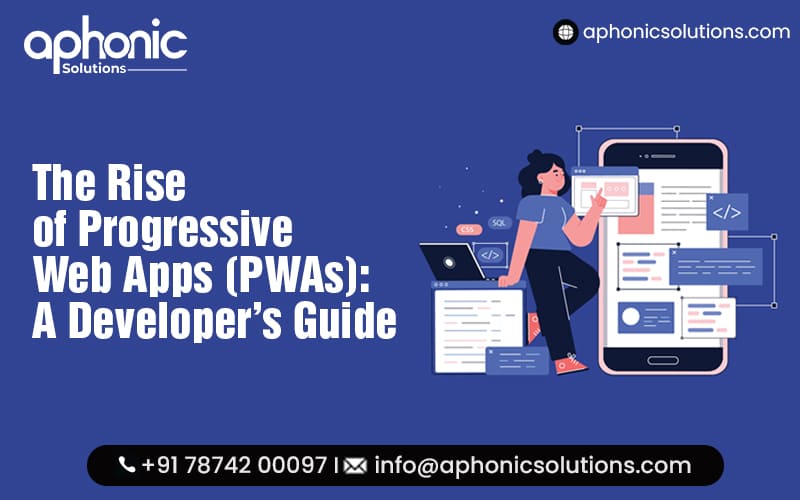In the digital landscape, Progressive Web Apps (PWAs) have revolutionized web development. These versatile technologies seamlessly blend the best of traditional websites and apps, offering a professional web presence that can significantly boost your business. By not leveraging PWAs, you’re missing out on higher conversions, lower development costs, and better engagements. This is the developer’s guide to unlocking the full potential of PWAs and the best practices to follow.
What are Progressive Web Apps (PWAs)?
A PWA is built using web technology but offers users a similar experience to a native mobile or web app. Progressive web apps can run on various platforms and devices from a single source code. Moreover, instead of using resources in an app, you can install PWA on your device that works offline and in the background by integrating other apps installed on the device. Want to get the best of mobile and web technologies leveraging PWA? Aphonic Solutions is the best web development company in Rajkot, offering top-notch, well-designed, and architected websites and mobile apps. Contact us for more info.
Step-by-step Guide to Progressive Web App Development
Following are the steps to create an intuitive, high-performance, responsive, and high-speed PWAs:
Step 1: Plan the Scope of Your PWA
At the initial stage, determine what type of app you want to create, whether you want a basic PWA with core functionality or a more advanced PWA with custom features.
- Determine PWA Goal: Identify the primary purpose of your PWA and what it should provide to users.
- Select Between Basic & Advanced PWA: A basic PWA provides essential features like responsiveness, fast loading, offline support, and other features. And advanced offers features such as push notifications & native app integration.
Step 2: Develop App Shell
The app shell forn serves as the cornerstone of the PWA user interface. This consists of minimal HTML, Javascript, and CSS to support the app’s basic layout and navigation. Create a separate CSS file to define colour, layout and other visual content to give the app a consistent and clean look.
- Develop a basic HTML layout with essential elements such as header, footer, and content area.
- Create a Javascript file to manage dynamic behaviour and interactions such as user events, extracting information from APIs, and toggling navigational menus.
- Now add a service file to cache shell files for quick loading time.
- Import or register service worker index.js.
- Ensure the app shell is light to enhance performance.
Step 3: Create the Front-end of Your PWA
After creating the app shell, develop the front-end of your PWA. For interactive and responsive user interfaces, you use advanced technologies such as CSS3 and HTML5 and Javascript frameworks like Angular, Vue.js, and React.
Step 4: Implement Service Worker for Your PWA
The service workers are essential aspects that allow for work offline, background synchronization, push notifications, and functionality features. Implementing service workers helps to cache critical assets and data so that the app can work also when the user is offline.
Step 5: Develop a Web App Manifest
A web app manifest is a JSON file that offers metadata of PWA, including name, description, icons, and selected display mode. Build a manifest file and add important details like display orientation, URL, and theme colour. This helps to improve the discoverability and usability of PWA, making it more appealing to users. To create a web app manifest, use tools like PWAbuilder, Manifest Generator, Sitebeam, Chrome DevTools, Manifest Validator, and others.
Step 6: Integrate Push Notifications
Push notifications are great tools to keep users engaged. Incorporate personalized notifications, analytics tracking to deliver messages to users, and subscription management. Ensure compatibility across different browsers and devices for flawless message delivery.
Step 7: Optimize the Performance of PWA
The best practice to optimize the performance of PWA is implementing performance monitoring tools such as WebPage Test and LightHouse to identify and fix troubleshooting. Also, images can be optimized through compression tools like TinyPNG and ImageOptim, as well as lazy loading with libraries such as Lazy Sizes.
Step 8: Test & Deploy Progressive Web Application
Before launching your PWA, it’s essential to thoroughly test it on different devices, browsers, and network conditions. Tools like Sauce Labs and BrowserStack, along with functional testing frameworks like Cypress or Jest, ensure that your PWA is of the highest quality. Performance testing frameworks such as GTmetrix, LightHouse, and WebPageTest further guarantee a flawless user experience.
Regularly update the PWA with new features, fix bugs, and performance optimization to make the most out of the web app. Looking for web development in Rajkot? Take your business to the next level with the progressive web app; get in touch with Aphonic Solutions.


